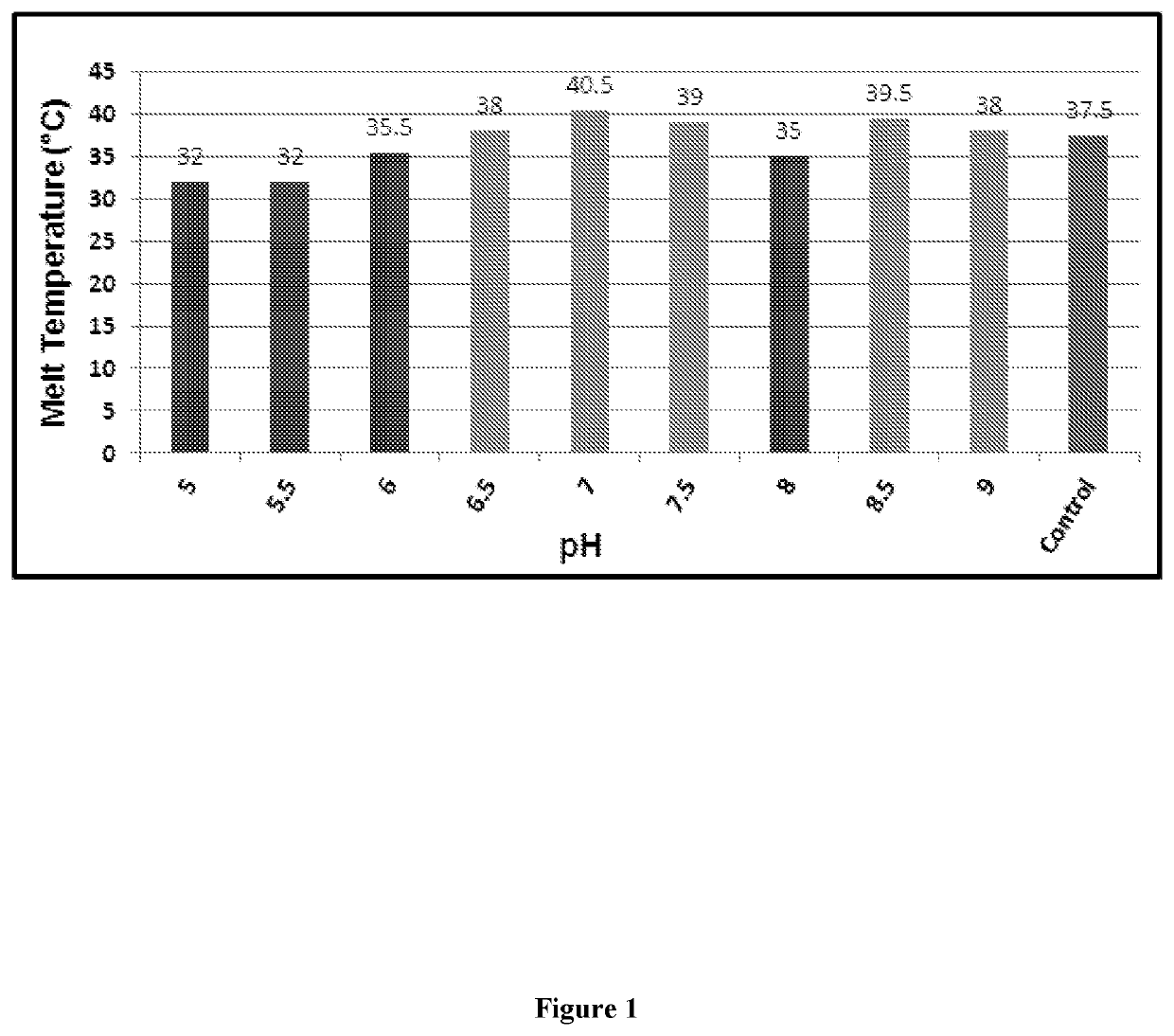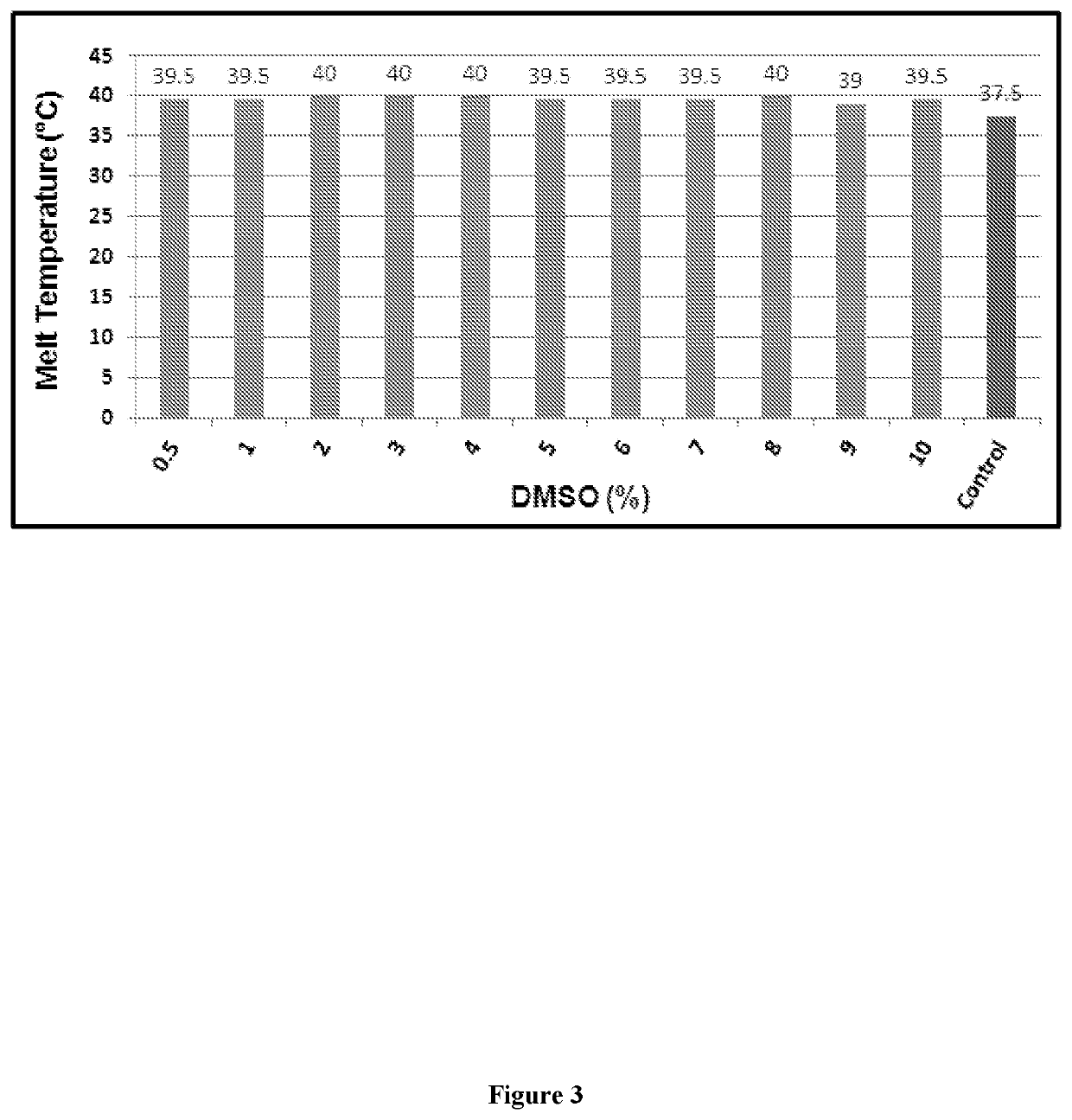Designing customized protein-specific buffer system
a protein-specific buffer and buffer system technology, applied in the field of protein chemistry, can solve the problems of limited commercially available instruments for protein melting point temperature scans, unresolved problems known to exist, and the ph of a solution is not changed, so as to prevent the effect of changing the ph of a solution
- Summary
- Abstract
- Description
- Claims
- Application Information
AI Technical Summary
Benefits of technology
Problems solved by technology
Method used
Image
Examples
example i
Dwarf27 Protein Stability Screen
[0188]The Dwarf27 protein was screened in an MES-BTP buffer mixture to provide an optimal buffer formulation using an integrated analysis of protein melting temperature point data collected from: i) an ammonium sulphate screen (FIG. 18A); ii) a urea screen (FIG. 18B); iii) a pH screen (FIG. 18C); iv) a DMSO screen (FIG. 18D); v) a metal ion screen (FIG. 18E); vi) a Hoefmiester series screen (FIG. 18F); vii) a third buffer screen (FIG. 18G); viii) a glycerol screen (FIG. 18H); and xi) an amino acid screen (FIG. 18I). Data was collected using a Spyro Orange fluorophore.
[0189]These data suggest that a customized buffer system for Dwarf27 may include: pH 6.5; 7% DMSO; 5-25 μM cobalt chloride; 50 mM sodium phosphate dibasic; 100 mM PIPES; 2.5% glycerol; and 25 mM glutamic acid.
[0190]The integrated analysis compared the differences in inflection points of these protein melting temperature point screens to identify Dwarf27 protein melting point profiles. See...
example ii
MX-4 Protein Stability Screen
[0191]The MX-4 protein was screened in an MES-BTP buffer mixture to provide an optimal buffer formulation using an integrated analysis of protein melting temperature point data collected from: i) an ammonium sulphate screen (FIG. 20A); ii) a urea screen (FIG. 20B); iii) a pH screen (FIG. 20C); iv) a DMSO screen (FIG. 20D); v) a metal ion screen (FIG. 20E); vi) a Hoefmiester series screen (FIG. 20F); vii) a third buffer screen (FIG. 20G); viii) a glycerol screen (FIG. 20H); and xi) an amino acid screen (FIG. 20I). Data was collected using a Spyro Orange fluorophore
[0192]These data suggest that a customized buffer system for MX-4 may include: 1.2 M ammonium sulphate; >9 pH; 25 μM manganese chloride; 50 mM magnesium chloride hexahydrate; 50 mM calcium chloride dihydrate; and 17.5% glycerol.
[0193]The integrated analysis compared the differences in inflection points of these protein melting temperature point screens to identify a MX-4 protein melting point pr...
example iii
Differential Scanning Fluorimetry
[0194]Materials: A fluorometer equipped with temperature control or similar instrumentation (RT-PCR machines); suitable fluorescent dye (e.g., CYPRO Orange); a suitable assay plate, such as 96 well RT-PCR plate.
[0195]Compound solutions: Test ligands are prepared at a 50- to 100-fold concentrated solution, generally in the 10-100 mM range. For titration, a typical experimental protocol employs a set of 12 well, comprising 11 different concentrations of a test compound with a single negative control well.
[0196]Protein solution: Typically, target protein is diluted from a concentrated stock to a working concentration of ˜0.5-5 μM protein with dye into a suitable assay buffer. The exact concentrations of protein and dye are defined by experimental assay development studies.
[0197]Centrifugation and oil dispense: A brief centrifugation (˜1000×g-force, 1 min) of the assay plate to mix compounds into the protein solution, 1-2 μl silicone oil to prevent the e...
PUM
| Property | Measurement | Unit |
|---|---|---|
| temperature | aaaaa | aaaaa |
| temperature | aaaaa | aaaaa |
| pH | aaaaa | aaaaa |
Abstract
Description
Claims
Application Information
 Login to View More
Login to View More - R&D
- Intellectual Property
- Life Sciences
- Materials
- Tech Scout
- Unparalleled Data Quality
- Higher Quality Content
- 60% Fewer Hallucinations
Browse by: Latest US Patents, China's latest patents, Technical Efficacy Thesaurus, Application Domain, Technology Topic, Popular Technical Reports.
© 2025 PatSnap. All rights reserved.Legal|Privacy policy|Modern Slavery Act Transparency Statement|Sitemap|About US| Contact US: help@patsnap.com



